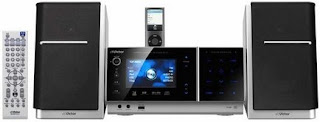The Toshiba Portege R400 measures 12 inches wide, 9.4 inches deep, and 1.25 inches high, slightly smaller than the Apple MacBook. Like the Vista based HP Pavilion tx1000us, the Portege R400 has a comfortable full size keyboard and a 12.1 inch screen that is a little on the small side for long term use.
The Portege R400 weighs 3.8 pounds (4.6 pounds with the AC adapter), which is just about right for a thin and light notebook youd carry around on a frequent basis. The systems base, screen bezel, and spine are black, but the lid and the keyboard tray are white, giving it an almost Mac like look, especially when closed. The center hinge is solid and literally snaps into place, letting you know its correctly situated.
Unlike the HP Pavilion tx1000us, the Portege R400s tablet screen is of the traditional, active stylus type, and youll need to use the included stylus to control it. Turning the screen 180 degrees and folding it down over the keyboard automatically switches the display into tablet mode, although we had trouble further rotating the display orientation with the screen rotation button after that.

By fishing around the various Toshiba and Windows tablet settings menus, we were able to figure out that the rotation button was assigned to another task by default, a situation easily remedied.
The other controls sitting below the LCD buttons for email and locking the system, and a small thumb stick for scrolling all worked correctly, as did the fingerprint reader.
Sitting on the front edge of the system is a small OLED readout, called the Toshiba Edge Display. This, by default, shows you the time, the battery level, and the wireless signal strength, but it can also be used with a new Windows Vista feature called Active Notification. If you set up a POP3 email account with Outlook 2007, Active Notifications allows the systems wireless connection to stay active (or cycle on and off periodically) even when the laptop is closed and in sleep mode. If a new email message comes in, the Edge Display can display an appropriate icon.
Naturally, keeping the wireless connection on will have an impact on battery life. We havent had time to set up Outlook yet, so well examine this features usefulness in a later update to this review. Connections are somewhat skimpier than were used to having with a modern laptop, and include two USB 2.0 jacks, headphone and mic jacks, a PC Card slot, and a VGA output. On such a pricey and otherwise cutting edge laptop, we expected more ports and slots, including FireWire, a media card reader, and an ExpressCard slot.
Networking equipment includes a Gigabit Ethernet jack, integrated 802.11b/g wireless, and built in EV-DO from Verizon Wireless (which requires a separate subscription). Toshibas proprietary connection utility makes setting up the EV-DO signal almost completely painless. Given its $3,500 price, we were somewhat disappointed with the components on our review unit.
While definitely small, the Portege R400 is not an ultra portable system, so we could reasonably expect an Intel Core 2 Duo processor, not a slower Core Duo (in this case the ultra low voltage 1.2GHz U2500). The 2GB of DDR2 RAM is a good choice for Windows Vista, but the 80GB hard drive, at a slower 4,200rpm speed, was disappointing. The DVD burner is also shunted off to an external add on box, something weve seen in ultra portable systems, but rarely, if at all, in a laptop this size.































